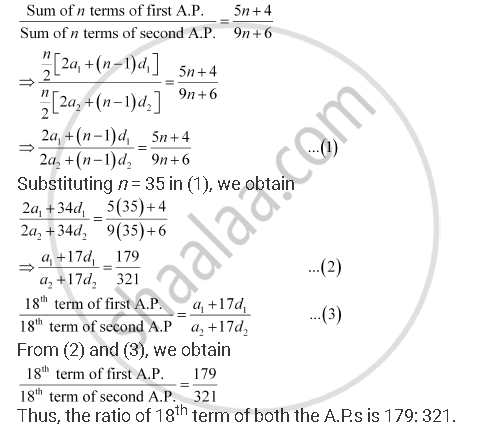Advertisements
Advertisements
प्रश्न
The sums of n terms of two arithmetic progressions are in the ratio 5n + 4: 9n + 6. Find the ratio of their 18th terms
उत्तर
Let a1, a2, and d1, d2 be the first terms and the common difference of the first and second arithmetic progression respectively.
According to the given condition,

APPEARS IN
संबंधित प्रश्न
How many terms of the A.P. -6 , `-11/2` , -5... are needed to give the sum –25?
If the sum of a certain number of terms of the A.P. 25, 22, 19, … is 116. Find the last term
Find the sum of all numbers between 200 and 400 which are divisible by 7.
Let < an > be a sequence defined by a1 = 3 and, an = 3an − 1 + 2, for all n > 1
Find the first four terms of the sequence.
Let < an > be a sequence. Write the first five term in the following:
a1 = 1 = a2, an = an − 1 + an − 2, n > 2
Show that the following sequence is an A.P. Also find the common difference and write 3 more terms in case.
3, −1, −5, −9 ...
Find:
10th term of the A.P. 1, 4, 7, 10, ...
Find:
18th term of the A.P.
\[\sqrt{2}, 3\sqrt{2}, 5\sqrt{2},\]
If the sequence < an > is an A.P., show that am +n +am − n = 2am.
Which term of the A.P. 3, 8, 13, ... is 248?
Which term of the A.P. 4, 9, 14, ... is 254?
Which term of the sequence 24, \[23\frac{1}{4,} 22\frac{1}{2,} 21\frac{3}{4}\]....... is the first negative term?
The 6th and 17th terms of an A.P. are 19 and 41 respectively, find the 40th term.
Find the 12th term from the following arithmetic progression:
3, 8, 13, ..., 253
How many numbers are there between 1 and 1000 which when divided by 7 leave remainder 4?
Find the sum of the following serie:
2 + 5 + 8 + ... + 182
Find the sum of all natural numbers between 1 and 100, which are divisible by 2 or 5.
Find the sum of all integers between 84 and 719, which are multiples of 5.
Find the sum of all even integers between 101 and 999.
Find the sum of all those integers between 100 and 800 each of which on division by 16 leaves the remainder 7.
Find the sum of odd integers from 1 to 2001.
In an A.P. the first term is 2 and the sum of the first five terms is one fourth of the next five terms. Show that 20th term is −112.
If a, b, c is in A.P., prove that:
a2 + c2 + 4ac = 2 (ab + bc + ca)
A farmer buys a used tractor for Rs 12000. He pays Rs 6000 cash and agrees to pay the balance in annual instalments of Rs 500 plus 12% interest on the unpaid amount. How much the tractor cost him?
A carpenter was hired to build 192 window frames. The first day he made five frames and each day thereafter he made two more frames than he made the day before. How many days did it take him to finish the job?
We know that the sum of the interior angles of a triangle is 180°. Show that the sums of the interior angles of polygons with 3, 4, 5, 6, ... sides form an arithmetic progression. Find the sum of the interior angles for a 21 sided polygon.
If the sums of n terms of two arithmetic progressions are in the ratio 2n + 5 : 3n + 4, then write the ratio of their m th terms.
In n A.M.'s are introduced between 3 and 17 such that the ratio of the last mean to the first mean is 3 : 1, then the value of n is
If Sn denotes the sum of first n terms of an A.P. < an > such that
If the sum of n terms of an A.P., is 3 n2 + 5 n then which of its terms is 164?
If the sum of n terms of an A.P. is 2 n2 + 5 n, then its nth term is
If a1, a2, a3, .... an are in A.P. with common difference d, then the sum of the series sin d [sec a1 sec a2 + sec a2 sec a3 + .... + sec an − 1 sec an], is
If n arithmetic means are inserted between 1 and 31 such that the ratio of the first mean and nth mean is 3 : 29, then the value of n is
The first three of four given numbers are in G.P. and their last three are in A.P. with common difference 6. If first and fourth numbers are equal, then the first number is
The first term of an A.P.is a, and the sum of the first p terms is zero, show that the sum of its next q terms is `(-a(p + q)q)/(p - 1)`
Find the rth term of an A.P. sum of whose first n terms is 2n + 3n2
If n AM's are inserted between 1 and 31 and ratio of 7th and (n – 1)th A.M. is 5:9, then n equals ______.
